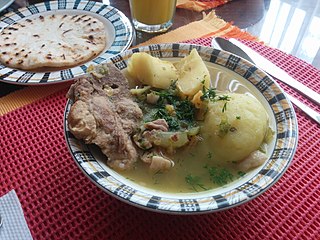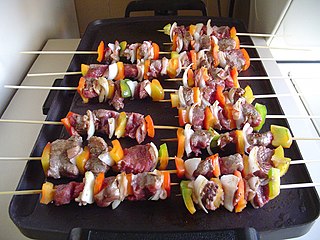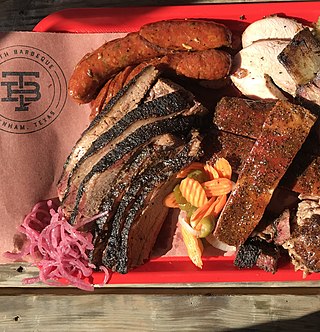
A hamburger, or simply a burger, is a dish consisting of fillings—usually a patty of ground meat, typically beef—placed inside a sliced bun or bread roll. The patties are often served with cheese, lettuce, tomato, onion, pickles, bacon, or chilis with condiments such as ketchup, mustard, mayonnaise, relish or a "special sauce", often a variation of Thousand Island dressing, and are frequently placed on sesame seed buns. A hamburger patty topped with cheese is called a cheeseburger. Under some definitions, and in some cultures, a burger is considered a sandwich.

A cheesesteak is a sandwich made from thinly sliced pieces of beefsteak and melted cheese in a long hoagie roll. A popular regional fast food, it has its roots in the United States city of Philadelphia, Pennsylvania.

Chateaubriand is a dish that traditionally consists of a large front cut fillet of tenderloin grilled between two lesser pieces of meat that are discarded after cooking. While the term originally referred to the preparation of the dish, Auguste Escoffier named the specific front cut of the tenderloin the Chateaubriand.

Churrasco is the Portuguese and Spanish name for grilled beef prominent in South American and Iberian cuisines, and in particular in Bolivia, Brazil, Uruguay, and Argentina. The term is also used in other Spanish- and Portuguese-speaking countries for a variety of different meat products.

Torta is a culinary term that can, depending on the cuisine, refer to cakes, pies, flatbreads, sandwiches, or omelettes.

Sancocho is a traditional stew in several Caribbean and Latin American cuisines. Latin variations represent popular national dishes in Dominican Republic, Colombia, Cuba, Honduras, Mexico, Panama, Puerto Rico, Trinidad and Tobago, and Venezuela. It usually consists of large pieces of meat, tubers and vegetables served in a broth.

Sopa de mondongo is a soup that originally came from Colombia, Puerto Rico and the Dominican Republic. It is made from diced tripe slow-cooked with vegetables such as bell peppers, onions, carrots, cabbage, celery, tomatoes, cilantro, garlic or root vegetables. The dish is generally prepared in former Spanish colonies in Latin America, Caribbean, and in the Philippines. The proposed etymology for mondongo is in the African Kikongo language, meaning “intestines, entrails of certain animals.

Honduran cuisine is a fusion of Mesoamerican, Spanish, Caribbean and African cuisines. There are also dishes from the Garifuna people. Coconut and coconut milk are featured in both sweet and savory dishes. Regional specialties include sopa de caracol, fried fish, tamales, carne asada and baleadas. Other popular dishes include meat roasted with chismol and carne asada, chicken with rice and corn, and fried fish with pickled onions and jalapeños. In the coastal areas and the Bay Islands, seafood and some meats are prepared in many ways, including with coconut milk. Among the soups the Hondurans enjoy are bean soup, mondongo soup, seafood soups and beef soups. Generally all of these soups are mixed with plantains, yuca, and cabbage, and served with corn tortillas.

A sope is a traditional Mexican dish consisting of a fried masa base with savory toppings. Also known as picadita, it originates in the central and southern parts of Mexico, where it was sometimes first known as pellizcadas. It is an antojito, which at first sight looks like an unusually thick tortilla with vegetables and meat toppings.

Mexican street food, called antojitos, is prepared by street vendors and at small traditional markets in Mexico. Street foods include tacos, tamales, gorditas, quesadillas, empalmes, tostadas, chalupa, elote, tlayudas, cemita, pambazo, empanada, nachos, chilaquiles, fajitas, tortas, even hamburgers and hot dogs, as well as fresh fruits, vegetables, beverages and soups such as menudo, pozole and pancita. Most are available in the morning and the evening, as mid-afternoon is the time for the main formal meal of the day. Mexico has one of the most extensive street food cultures in Latin America, and Forbes named Mexico City as one of the foremost cities in the world in which to eat on the street.

A steak sandwich is a sandwich prepared with steak that has been broiled, fried, grilled, barbecued or seared using steel grates or gridirons, then served on bread or a roll. Steak sandwiches are sometimes served with toppings of cheese, onions, mushrooms, peppers, tomatoes, and in some instances fried eggs, coleslaw, and french fries.

The bocadillo or bocata, in Spain, is a sandwich made with Spanish bread, usually a baguette or similar type of bread, cut lengthwise. Traditionally seen as a humble food, its low cost has allowed it to evolve over time into an iconic piece of cuisine. In Spain, they are often eaten in cafes and tapas bars.
The second season of the American reality competition show Top Chef Masters was announced on October 22, 2009. In addition, it was announced that Gail Simmons would be added as a critic. The season premiered on April 7, 2010 with 22 chefs competing against each other in weekly challenges. In the season finale that premiered on June 9, 2010, Marcus Samuelsson was crowned Top Chef Master.

Texan cuisine is the food associated with the Southern U.S. state of Texas, including its native Southwestern cuisine–influenced Tex-Mex foods. Texas is a large state, and its cuisine has been influenced by a wide range of cultures, including Tejano/Mexican, Native American, Creole/Cajun, African-American, German, Czech, Southern and other European American groups. The cuisine of neighboring states also influences Texan cuisine, such as New Mexican cuisine and Louisiana Creole cuisine. This can be seen in the widespread usage of New Mexico chiles, Cayenne peppers, and Tabasco sauce in Texan cooking.

Breaded cutlet or braised cutlet is a dish made from coating a cutlet of meat with breading or batter and either frying or baking it.

Wasakaka is a savory sauce found in Dominican and Venezuelan cuisine. The name is also spelled guasacaca, pronounced the same. It is often used in chicken dishes.

Shredded beef, also known as pulled beef, is a preparation of beef that features in dishes from various cuisines. Shredded beef is sometimes prepared using beef brisket and chuck roast. Pot roast is also sometimes shredded.

Steak and eggs is a dish of beefsteak and fried eggs. Originating in Australian cuisine, it is most typically served as a breakfast or brunch food.

Carne mechada is a stewed meat dish traditional of Spanish and Latin American cuisine. It involves slow-cooking or braising a piece of meat, often beef or pork, until it becomes tender and easy to shred.





















